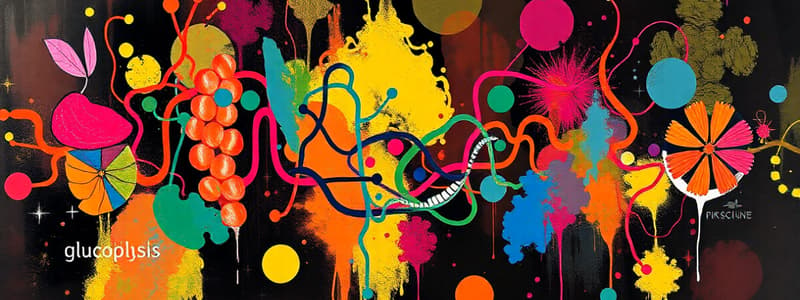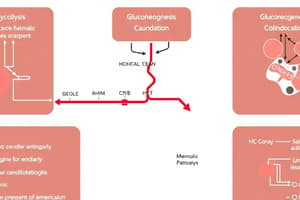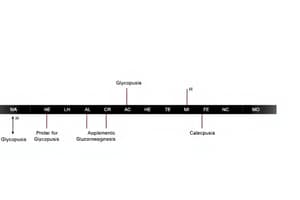Podcast
Questions and Answers
Which enzyme is responsible for converting 2-Phosphoglycerate to Phosphoenolpyruvate?
Which enzyme is responsible for converting 2-Phosphoglycerate to Phosphoenolpyruvate?
- Pyruvate Kinase
- Aldolase
- Enolase (correct)
- Phosphoglycerate Kinase
In which step of glycolysis is ATP synthesized for the first time, resulting in a net gain of ATP?
In which step of glycolysis is ATP synthesized for the first time, resulting in a net gain of ATP?
- Step 7
- Step 10 (correct)
- Step 3
- Step 1
Which of the following is NOT an allosteric activator of pyruvate kinase?
Which of the following is NOT an allosteric activator of pyruvate kinase?
- ATP (correct)
- AMP
- Acetyl-CoA (correct)
- Fructose-1,6-bisphosphate
Which step in glycolysis involves a change in carbon chain length?
Which step in glycolysis involves a change in carbon chain length?
What is the main purpose of step 8 in glycolysis?
What is the main purpose of step 8 in glycolysis?
Which of the following steps in glycolysis produces NADH?
Which of the following steps in glycolysis produces NADH?
Why is the conversion of 2-Phosphoglycerate to Phosphoenolpyruvate important in glycolysis?
Why is the conversion of 2-Phosphoglycerate to Phosphoenolpyruvate important in glycolysis?
What is the net gain of ATP molecules per glucose molecule in glycolysis?
What is the net gain of ATP molecules per glucose molecule in glycolysis?
What is the fate of pyruvate under aerobic conditions?
What is the fate of pyruvate under aerobic conditions?
What is the primary role of NADH in glycolysis?
What is the primary role of NADH in glycolysis?
Which of the following molecules is NOT a precursor to glucose in gluconeogenesis?
Which of the following molecules is NOT a precursor to glucose in gluconeogenesis?
How does gluconeogenesis differ from the reverse of glycolysis?
How does gluconeogenesis differ from the reverse of glycolysis?
Why is gluconeogenesis considered a costly process?
Why is gluconeogenesis considered a costly process?
What is the role of the malate-aspartate shuttle in gluconeogenesis?
What is the role of the malate-aspartate shuttle in gluconeogenesis?
How does lactate contribute to gluconeogenesis?
How does lactate contribute to gluconeogenesis?
What is the primary regulatory mechanism for gluconeogenesis?
What is the primary regulatory mechanism for gluconeogenesis?
What is the key difference between step 8 of gluconeogenesis and step 3 of glycolysis?
What is the key difference between step 8 of gluconeogenesis and step 3 of glycolysis?
Which of the following is NOT a key characteristic of the pentose phosphate pathway?
Which of the following is NOT a key characteristic of the pentose phosphate pathway?
Which of the following molecules is a precursor for nucleotide synthesis?
Which of the following molecules is a precursor for nucleotide synthesis?
Why is the conversion of glucose-6-phosphate to glucose an exergonic reaction in step 10 of gluconeogenesis?
Why is the conversion of glucose-6-phosphate to glucose an exergonic reaction in step 10 of gluconeogenesis?
What is the significance of the conversion of glucose-6-phosphate to glucose taking place within the ER of liver and kidney cells?
What is the significance of the conversion of glucose-6-phosphate to glucose taking place within the ER of liver and kidney cells?
What is the main purpose of the preparatory phase in glycolysis?
What is the main purpose of the preparatory phase in glycolysis?
What is the role of hexokinase in glycolysis?
What is the role of hexokinase in glycolysis?
Why is the first step of glycolysis considered irreversible?
Why is the first step of glycolysis considered irreversible?
What is the primary function of the payoff phase in glycolysis?
What is the primary function of the payoff phase in glycolysis?
Under anaerobic conditions, what happens to pyruvate?
Under anaerobic conditions, what happens to pyruvate?
What is the role of NAD+ in glycolysis?
What is the role of NAD+ in glycolysis?
Which of the following statements correctly describes the energy balance of glycolysis?
Which of the following statements correctly describes the energy balance of glycolysis?
Which of the following statements about the conversion of glucose-6-phosphate to fructose-6-phosphate in glycolysis is incorrect?
Which of the following statements about the conversion of glucose-6-phosphate to fructose-6-phosphate in glycolysis is incorrect?
What is the primary role of phosphofructokinase-1 (PFK-1) in glycolysis?
What is the primary role of phosphofructokinase-1 (PFK-1) in glycolysis?
Which of the following is NOT a product of glycolysis?
Which of the following is NOT a product of glycolysis?
What is the primary reason why the conversion of dihydroxyacetone phosphate (DHAP) to glyceraldehyde-3-phosphate (G-3-P) is important in glycolysis?
What is the primary reason why the conversion of dihydroxyacetone phosphate (DHAP) to glyceraldehyde-3-phosphate (G-3-P) is important in glycolysis?
Which of the following statements correctly describes the energy changes that occur during the first half of glycolysis?
Which of the following statements correctly describes the energy changes that occur during the first half of glycolysis?
How does the phosphorylation of glyceraldehyde-3-phosphate to 1,3-bisphosphoglycerate contribute to the production of ATP in glycolysis?
How does the phosphorylation of glyceraldehyde-3-phosphate to 1,3-bisphosphoglycerate contribute to the production of ATP in glycolysis?
Which of the following enzymes is responsible for catalyzing the irreversible commitment step of glycolysis?
Which of the following enzymes is responsible for catalyzing the irreversible commitment step of glycolysis?
Which of the following enzymes in glycolysis is a regulatory enzyme that is subject to feedback inhibition?
Which of the following enzymes in glycolysis is a regulatory enzyme that is subject to feedback inhibition?
In step 7 of glycolysis, how many molecules of ATP are generated?
In step 7 of glycolysis, how many molecules of ATP are generated?
Which of the following reactions is most likely to be endergonic?
Which of the following reactions is most likely to be endergonic?
Which of the following statements is TRUE regarding the regulation of glycolysis?
Which of the following statements is TRUE regarding the regulation of glycolysis?
Which of the following is NOT a pathway that can feed into glycolysis?
Which of the following is NOT a pathway that can feed into glycolysis?
In step 6, how many molecules of NADH are produced?
In step 6, how many molecules of NADH are produced?
Which of the following statements is TRUE about the standard free energy change (Delta G) for glycolysis reactions?
Which of the following statements is TRUE about the standard free energy change (Delta G) for glycolysis reactions?
Which type of reaction is catalyzed by enolase in step 9 of glycolysis?
Which type of reaction is catalyzed by enolase in step 9 of glycolysis?
Flashcards
Glycolysis
Glycolysis
The metabolic pathway that converts glucose into pyruvate, producing energy.
Preparatory (Investment) Phase
Preparatory (Investment) Phase
The first phase of glycolysis where glucose is phosphorylated and ATP is used.
Payoff Phase
Payoff Phase
The second phase of glycolysis where energy is generated, producing ATP and NADH.
Pyruvate
Pyruvate
Signup and view all the flashcards
Aerobic Conditions
Aerobic Conditions
Signup and view all the flashcards
Anaerobic Conditions
Anaerobic Conditions
Signup and view all the flashcards
NAD+
NAD+
Signup and view all the flashcards
Glyceraldehyde-3-phosphate
Glyceraldehyde-3-phosphate
Signup and view all the flashcards
Dehydrogenase
Dehydrogenase
Signup and view all the flashcards
Phosphoglycerate Kinase
Phosphoglycerate Kinase
Signup and view all the flashcards
Phosphoenolpyruvate
Phosphoenolpyruvate
Signup and view all the flashcards
ATP Energy Input
ATP Energy Input
Signup and view all the flashcards
Isomerization
Isomerization
Signup and view all the flashcards
Aldehyde Oxidation
Aldehyde Oxidation
Signup and view all the flashcards
P-bond Cleavage
P-bond Cleavage
Signup and view all the flashcards
Multiple Feeder Pathways
Multiple Feeder Pathways
Signup and view all the flashcards
Step 7 of Glycolysis
Step 7 of Glycolysis
Signup and view all the flashcards
1,3-Bisphosphoglycerate
1,3-Bisphosphoglycerate
Signup and view all the flashcards
Step 8 of Glycolysis
Step 8 of Glycolysis
Signup and view all the flashcards
2-Phosphoglycerate
2-Phosphoglycerate
Signup and view all the flashcards
Phosphoenolpyruvate (PEP)
Phosphoenolpyruvate (PEP)
Signup and view all the flashcards
Step 10 of Glycolysis
Step 10 of Glycolysis
Signup and view all the flashcards
pyruvate kinase
pyruvate kinase
Signup and view all the flashcards
Allosteric Regulation of Pyruvate Kinase
Allosteric Regulation of Pyruvate Kinase
Signup and view all the flashcards
Hexokinase Regulation
Hexokinase Regulation
Signup and view all the flashcards
Mg2+ Role
Mg2+ Role
Signup and view all the flashcards
PFK-1 Function
PFK-1 Function
Signup and view all the flashcards
Aldolase Cleavage
Aldolase Cleavage
Signup and view all the flashcards
Triose Phosphate Isomerase
Triose Phosphate Isomerase
Signup and view all the flashcards
NAD+ Reduction
NAD+ Reduction
Signup and view all the flashcards
Hexokinase
Hexokinase
Signup and view all the flashcards
Trehalose
Trehalose
Signup and view all the flashcards
Aerobic Pyruvate Fate
Aerobic Pyruvate Fate
Signup and view all the flashcards
Lactate Production
Lactate Production
Signup and view all the flashcards
Gluconeogenesis
Gluconeogenesis
Signup and view all the flashcards
Gluconeogenesis Step 1
Gluconeogenesis Step 1
Signup and view all the flashcards
Malate-Aspartate Shuttle
Malate-Aspartate Shuttle
Signup and view all the flashcards
NADH Consumption
NADH Consumption
Signup and view all the flashcards
Fructose-1,6-bisphosphate
Fructose-1,6-bisphosphate
Signup and view all the flashcards
Glucose-6-phosphate
Glucose-6-phosphate
Signup and view all the flashcards
Pentose Phosphate Pathway
Pentose Phosphate Pathway
Signup and view all the flashcards
Study Notes
Carbohydrate Metabolism
- Carbohydrates are a major fuel source for organisms.
- Complete oxidation of glucose releases ~2,840 kJ/mol of energy.
- Glucose can be used to synthesize the carbon skeletons of many other molecules.
- In plants and animals, glucose can be stored as polysaccharides (e.g., glycogen, starch) or sucrose.
- Glucose can be oxidized to a 3-carbon compound (pyruvate) via glycolysis.
- Glucose can be oxidized to pentoses (used in nucleic acid synthesis).
Outline of the Section
- Carbohydrates: nutritional perspective
- Metabolism of carbohydrates
- Metabolism of carbohydrates: nutritional perspective
Glucose
- Major fuel source for most organisms.
- Oxidation yields approximately -2,840 kJ/mol of energy
- Precursor for many molecules
- Stored in higher plants and animals as polysaccharides like sucrose.
- Oxidized to pyruvate via glycolysis.
- Oxidized to pentoses for nucleic acid synthesis
Fates of Glucose
- Synthesis of structural polysaccharides for cell walls of bacteria and plants and extracellular matrix components.
- Synthesis of structural polymers (e.g., cell wall polysaccharides)
- Oxidation via pentose phosphate pathway (generates NADPH, used in biosynthesis of lipids & nucleotides)
- Oxidation via Glycolysis (production of ATP and pyruvate)
- Storage (glycogen, starch) for later energy needs
Glycolysis
- Almost universal pathway for carbohydrate catabolism.
- Stores energy in ATP and NADH.
- Anaerobic or aerobic catabolism of glucose.
- Two-phase process: investment and payoff phases.
- Net gain of 2 ATP per glucose molecule.
Fates of Pyruvate
- Aerobic conditions: Pyruvate is oxidized to acetyl-CoA, which enters the citric acid cycle.
- Anaerobic conditions (e.g., animals, microbes): Pyruvate converted to lactate to regenerate NAD+ which is needed to continue glycolysis (lactic acid fermentation)
Summary of Glycolysis and Energetics
- 5.2% of glucose energy is removed in glycolysis (oxidation-reduction only).
- Much energy remains in pyruvate for further oxidation.
- Glycolysis: Glucose + 2ADP + 2NAD+ → 2Pyruvate + 2ATP + 2NADH + 2H+ + 2H₂O
- Net reaction: Glucose + 2NAD+ +2ADP + 2Pi → 2 Pyruvate + 2NADH + 2H+ + 2ATP + 2H₂O
Glycolysis: Steps 1-10 (Detailed)
- Each section (1-10) outlines individual enzymatic steps during glycolysis, highlighting the inputs, outputs, reaction types (exergonic or endergonic), involved enzymes, thermodynamic parameters, and regulation details.
Other Pathways Can Lead to the Glycolysis Pathway
- Multiple pathways feed into glycolysis, including those involving disaccharides (e.g., sucrose, lactose) and polysaccharides (e.g., starch, glycogen).
- These pathways break down complex carbohydrates into single sugars that can enter glycolysis.
Monosaccharide Feed-in to Glycolysis
- Many monosaccharides like fructose, mannose, and galactose can be converted into glucose or glycolysis intermediates.
Anaerobic Metabolism (Pyruvate to Lactate)
- During vigorous exercise when oxygen supply is limited, lactate is formed from pyruvate.
- This regenerates NAD+ needed for glycolysis
- The accumulation of lactate leads to muscle pain.
Anaerobic Metabolism (Pyruvate to Ethanol)
- In some microorganisms (yeast), pyruvate is decarboxylated to acetaldehyde, then to ethanol.
- This regenerates NAD+ needed for glycolysis.
From Catabolism to Anabolism
- Convergent catabolic pathways and divergent anabolic pathways often share related intermediates.
- ATP, NADH/NADPH are common precursors.
Carbohydrate Biosynthesis
- Focuses on how human (animal) cells synthesize carbohydrates, including glucose formation from various precursors.
- Pathways like gluconeogenesis convert lactate, amino acids, and other compounds into glucose
Gluconeogenesis
- Synthesis of glucose from non-carbohydrate precursors (e.g., lactate, amino acids, oxaloacetate).
- Bypass steps in the glycolysis reaction are used.
- The process consumes energy.
Glycolysis and Gluconeogenesis
- Seven reactions are common to both glycolysis and gluconeogenesis.
- Specific reactions bypass the three irreversible steps in glycolysis.
Pentose Phosphate Pathway
- An alongside glycolysis pathway that generates NADPH.
- The pathway offers alternative reactions to generate intermediates for nucleotide synthesis and reducing power.
- NADPH is critical for reductive biosynthesis in the body.
PPP, NADPH and Anti-oxidation
- NADPH is an essential reducing agent needed to protect cells from oxidative damage.
- NADPH levels can be used to determine the use of glucose in glycolysis or Pentose phosphate pathways
Additional Details (Steps, Enzymes, Mechanisms):
- Each step of glycolysis, gluconeogenesis, and the pentose phosphate pathways details are available in the provided documents. This is crucial for understanding their functions. (The specific mechanisms and functions of each enzyme involved in these processes are thoroughly covered in the detailed steps)
Studying That Suits You
Use AI to generate personalized quizzes and flashcards to suit your learning preferences.




